Economy of Sudan
The economy of Sudan has boomed on the back of increases in oil production, high oil prices, and large inflows of foreign direct investment until the second half of 2002. GDP growth registered more than 10% per year in 2006 and 2007. From 1997 to date, Sudan has been working with the IMF to implement macroeconomic reforms, including a managed float of the exchange rate. Sudan began exporting crude oil in the last quarter of 1999.
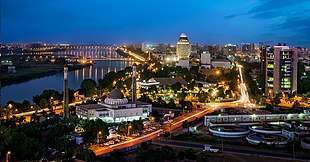 | |
| Currency | Sudanese pound (SDG) |
|---|---|
| Calendar Year | |
Trade organisations | AU, AfCFTA (signed), Arab League, COMESA, WTO |
Country group |
|
| Statistics | |
| Population | |
| GDP | |
| GDP rank | |
GDP growth |
|
GDP per capita | |
GDP per capita rank | |
GDP by sector |
|
| 81.3% (2020 est.)[5] | |
Population below poverty line | |
| 35.3 medium (2013)[9] | |
Labour force | |
Labour force by occupation |
|
| Unemployment | |
Main industries | oil, cotton ginning, textiles, cement, edible oils, sugar, soap distilling, shoes, petroleum refining, pharmaceuticals, armaments, automobile/light truck assembly, milling |
| External | |
| Exports | |
Export goods | gold; oil and petroleum products; cotton, sesame, livestock, peanuts, gum Arabic, sugar |
Main export partners |
|
| Imports | |
Import goods | foodstuffs, manufactured goods, refinery and transport equipment, medicines, chemicals, textiles, wheat |
Main import partners | |
FDI stock |
|
Gross external debt | |
| Public finances | |
| −10.6% (of GDP) (2017 est.)[6] | |
| Revenues | 8.48 billion (2017 est.)[6] |
| Expenses | 13.36 billion (2017 est.)[6] |
Foreign reserves | |
Agricultural production remains important, because it employs 80% of the work force and contributes a third of GDP. The Darfur conflict, the aftermath of two decades of civil war in the south, the lack of basic infrastructure in large areas, and a reliance by much of the population on subsistence agriculture ensure much of the population will remain at or below the poverty line for years despite rapid rises in average per capital income. In January 2007, the government introduced a new currency, the Sudanese Pound, at an initial exchange rate of $1.00 equals 2 Sudanese Pounds.
History since independence
Current GDP per capita of Sudan grew 46% in the 1960s, reaching a peak growth of 170% in the 1970s. But this proved unsustainable and growth consequently scaled back to 34% in the 1980s. Finally, it shrank by 26% in the 1990s.[15]
Until the early 1970s Sudan's agricultural output was mostly dedicated to internal consumption. In 1972 the Sudanese government became more pro-Western, and made plans to export food and cash crops. However, commodity prices declined throughout the 1970s causing economic problems for Sudan. At the same time, debt servicing costs, from the money spent mechanizing agriculture, rose. In 1978 the International Monetary Fund (IMF) negotiated a Structural Adjustment Program with the government. This further promoted the mechanized export agriculture sector. This caused great economic problems for the pastoralists of Sudan.
During the late 1970s and 1980s, the IMF, World Bank, and key donors worked closely to promote reforms to counter the effect of inefficient economic policies and practices. By 1984, a combination of factors, including drought, inflation, and confused application of Islamic law, reduced donor disbursements and capital flight led to a serious foreign-exchange crisis and increased shortages of imported inputs and commodities. More significantly, the 1989 revolution caused many donors in Europe, the U.S., and Canada to suspend official development assistance, but not humanitarian aid.
However, as Sudan became the world's largest debtor to the World Bank and International Monetary Fund by 1993, its relationship with the international financial institutions soured in the mid-1990s and has yet to be fully rehabilitated. The government fell out of compliance with an IMF standby program and accumulated substantial arrearages on repurchase obligations. A 4-year economic reform plan was announced in 1988 but was not pursued.
An economic reform plan was announced in 1989 and began implementing a 3-year economic restructuring program designed to reduce the public sector deficit, end subsidies, privatize state enterprises, and encourage new foreign and domestic investment. In 1993, the IMF suspended Sudan's voting rights and the World Bank suspended Sudan's right to make withdrawals under effective and fully disbursed loans and credits. Lome Funds and EU agricultural credits, totaling more than one billion euros, also were suspended.
Infrastructure
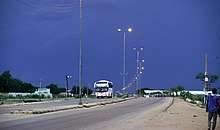

Sudan has a developed infrastructure comparable to most of Sub-Saharan Africa and many projects are taking place to develop it even further all across the country. Some parts of the country are better off—mainly in the northern states—due to oil productions and the wealth gained from it. The telephone system in Sudan is well equipped by regional standards, and is maintained by modern standards. One of Sudan's greatest projects was the Merowe Dam.
Khartoum was rewarded the Arab Capital of Culture in 2005. Modern buildings in Khartoum are on the rise due to the economic growth. However, since South Sudan independence a number of projects have been postponed due to economic recession after losing 75% of the oil. Transit fees of south Sudan will likely cut the loss greatly and the government economic emergency plan will end in 2015 bringing the economy back on track and after that, the economy will start developing rapidly with construction booms.
Retailing
Khartoum has one of the largest open markets in the region, the Souq Al Arabi. The market is spread over several blocks in the center of Khartoum proper just south of the Great Mosque (Mesjid al-Kabir) and the minibus station. It is divided into separate sections, including one focused entirely on gold. Al Qasr Street and Al Jamhoriyah Street are considered the most famous high streets in Khartoum State.
In 2010, Sudan's first medium scale shopping mall opened, located in the southern suburb Arkeweet. The Afra Mall has a supermarket, retail outlets, coffee shops, a bowling alley, movie theaters, and a children's playground. In 2011, Sudan opened the Hotel Section and part of the food court of the new, Cornithia hotel Tower. The Mall/Shopping section is still under construction.
Railways
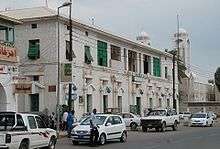
Sudan has 4,725 kilometers of narrow-gauge, single-track railroads that serve the northern and central portions of the country. The main line runs from Wadi Halfa on the Egyptian border to Khartoum and southwest to Al Ubayyid via Sannar and Kusti, with extensions to Nyala in Southern Darfur and Wau in Bahr al Ghazal.
Other lines connect Atbarah and Sannar with Port Sudan, and Sannar with Ad Damazin. A 1,400-kilometer line serves the al Gezira cotton-growing region. A modest effort to upgrade rail transport is currently underway to reverse decades of neglect and declining efficiency. Service on some lines may be interrupted during the rainy season.
Tourism
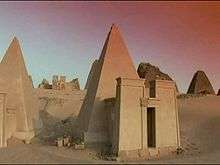
Sudan is one of the largest Arab nations. It is rich in history dating back to the period of Sudanese Nubia and Ancient Egypt. There are many pyramids all over Sudan, attracting many tourists from Syria, Egypt, Morocco, Jordan and other Arab countries, as well as tourists from Western nations. Sudan was voted the 8th most popular Arab nation to visit by the Council of Arab Economic Unity. Sudan also has many modern hotels including the five star Corinthia Hotel Khartoum in Khartoum. The government of Sudan also pledge $1 billion a year to increase the tourist industry.
Agriculture
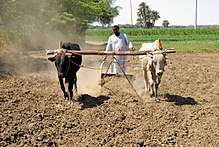
Primary resources are agricultural, including cotton, peanuts, gum arabic, and sesame seeds. Although the country is trying to diversify its cash crops, cotton and peanuts remain its major agricultural exports. Grain sorghum (dura) is the principal food crop, and wheat is grown for domestic consumption. Sesame seeds and peanuts are cultivated for domestic consumption and increasingly for export.
Three main agricultural sub-sectors are active in Sudan: pastoral livestock, cropping and fish production.[16] Livestock production has vast potential, and many animals, particularly cows, sheep, and camels, are exported to Saudi Arabia and other Arab countries. However, Sudan remains a net importer of food. Problems of investment finance, production and transportation remain the greatest constraints to a more dynamic agricultural economy. A major problem which has been growing for decades is the continual loss of open lands previously used for animal grazing to mechanized drylands and irrigated farming.[17]
Sudan has 84 million hectares of arable land and less than 20% is cultivated. Major agricultural projects such as the Gezera Scheme in Gezira state are underway in order to make Sudan food self-sufficient. Sudan is one of the world's potential breadbaskets and Sudan is nicknamed as the Arab world food basket as it accounts for 45% of arable land in the Arab world.Agricultural products in total account for about 95 percent of the country's exports. In 1998 there was an estimated 16.9 million hectares (41.8 million acres) of arable land and approximately 1.9 million hectares (4.7 million acres) set aside for irrigation, primarily in the north of the country along the banks of the Nile and other rivers.
Cash crops (as of 1999) grown under irrigation in these areas include cotton and cottonseed, which is of primary importance to the economy with 172,000 tons and 131,000 tons produced annually respectively,[18]sesame (220,000 tons), sugarcane (5,950,000 tons), peanuts (980,000 tons), dates (176,000 tons), citrus fruits, yams (136,000 tons), tomatoes (240,000 tons), mangoes, coffee, and tobacco.[18] The main subsistence crops produced in Sudan are sorghum (3,045,000 tons), millet (1,499,000 tons), wheat (168,000 tons), cowpeas, beans, pulses, corn (65,000), and barley.[18] Cotton is the principal export crop and an integral part of the country's economy and Sudan is the world's third largest producer of sesame after India and China.[18]
Industry
Sudan's rapid industrial development consists of agricultural processing, electronics assembly, plastics manufacturing, furniture, tanning, sugar production, meat processing and various light industries located in any of the 10 Industrial areas in Khartoum. due to the many countries depending on Sudan for medicines and medical services, Sudan is now concentrating on becoming a hub for the medical industry in East Africa, providing facilities and concessions for medical investments and succeeding in covering about 70% of needs and exporting to many neighboring nations. In recent years, the Giad Industrial Complex in Al Jazirah state introduced the assembly of small autos and trucks, and some heavy military equipment such as armored personnel carriers and the “Bashir” and "Zubair" main battle tanks as well as handguns, light and heavy machineguns and howitzers and, recently, drone production. Sudan is reputed to have great mineral resources, and exploration has started extensively for gold, of which is produced nearly 30 tons annually providing a great boost to the foreign exchange reserves of the nation, with the participation of many investment companies from all over the world. Quantities of asbestos, chromium, mica, kaolin and copper are now exploited commercially, especially for export to China.
Electricity generation
Sudan is seeking to expand its installed capacity of electricity generation of around 300 MW;of which 180 MW is hydroelectric and the rest thermal. European investors, considering the continuing U.S. economic, trade, and financial sanctions regime, are the most likely providers of technology for this purpose.
More than 70% of Sudan's hydropower comes from the Roseires Dam on the Blue Nile grid. Various projects are proposed to expand hydro-power, thermal generation, and other sources of energy, but so far the government has had difficulty arranging sufficient financing. A new dam which is being established in Merowe which has been opened in 2008 and generates 125 MW of electricity.
Petroleum
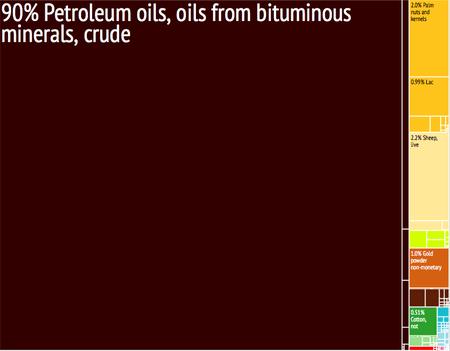
Extensive petroleum exploration first began in Sudan in the mid-1970s. Significant finds were made in the Upper Nile region and commercial quantities of oil began to be exported in October 2000, reducing Sudan's outflow of foreign exchange for imported petroleum products. Today, oil is an important export industry in Sudan. Estimates suggest that oil accounts for between 70% and 90% of Sudan's total exports. The primary importers of Sudanese oil are Japan, China, South Korea, Indonesia, and India.[19][20]
Most of Sudan's oil reserves are located in the Muglad and Melut rift basins in the south of the country.[21] Oil fields in the south, such as those at Heglig and in the South Sudanese state of Unity, formerly part of Sudanese territory, are linked to the country's refineries via pipelines. The two largest oil pipelines are the Greater Nile Oil Pipeline, which travels 1,600 kilometres from the Unity oil field to Port Sudan on the Red Sea via Khartoum, and the PetroDar pipeline, which extends 1,380 kilometres from the Palogue oil field in the Melut Basin to Port Sudan.[22][23]
Crude oil from the Muglad Basin is known as "Nile Blend" and is refined at the Khartoum crude oil refinery. In 2006, the China National Petroleum Corporation upgraded the Khartoum refinery, doubling its capacity to 100,000 barrels per day (16,000 m3/d). Oil from the Melud Basin is known as "Dar Blend" and is refined at the Port Sudan Refinery, which has a capacity of 21,700 barrels per day (3,450 m3/d). In 2005, the Sudanese government contracted Petronas to build a new refinery at Port Sudan.[21]
Sudan crude oil output is predicted to peak in 2008, although current revenue levels may be sustained for a decade or more.[24]
Gold
In September 2012, Sudanese President Omar al-Bashir opened the country's first gold refinery and it is speculated to be one of the largest such constructions in Africa.[25] The refinery will produce more than 328 tonnes of gold annually. Economic analysts say that the refinery is part of government's strategy to make up for lost oil revenue after the South Sudan split of 2011.[25]
The refinery will also be able to process silver and its opening should reduce the amount of gold and silver smuggled to other markets.[26] According to Reuters, Sudan hopes to double its gold revenues this year to $3 billion. In August 2012, the finance ministry of Sudan said that the export of gold ore from Sudan would be prohibited once the refinery was opened.[26]
Embargos and sanctions
On 3 November 1997, the U.S. government imposed a trade embargo against Sudan and a total asset freeze against the Government of Sudan under Executive Order 13067. The U.S. believed the Government of Sudan gave support to international terrorism, destabilized neighboring governments, and permitted human rights violations.[27] A consequence of the embargo is that U.S. corporations cannot invest in the Sudan oil industry, so companies in China, Malaysia and India are the major investors.[28]
Macro-economic trend
The following table shows the main economic indicators in 1980–2017.[29]
| Year | 1980 | 1985 | 1990 | 1995 | 2000 | 2005 | 2006 | 2007 | 2008 | 2009 | 2010 | 2011 | 2012 | 2013 | 2014 | 2015 | 2016 | 2017 |
|---|---|---|---|---|---|---|---|---|---|---|---|---|---|---|---|---|---|---|
| GDP in $ (PPP) |
12.2 bil. | 13.1 bil. | 14.8 bil. | 17.6 bil. | 21.4 bil. | 26.5 bil. | 35.8 bil. | 45.8 bil. | 54.5 bil. | 53.1 bil. | 65.6 bil. | 67.3 bil. | 68.1 bil. | 72.0 bil. | 82.1 bil. | 97.1 bil. | 95.5 bil. | 117.4 bil. |
| GDP per capita in $ (PPP) |
1,168 | 1,314 | 1,588 | 1,944 | 2,619 | 3,594 | 3,846 | 4,068 | 4,199 | 4,015 | 4,167 | 5,030 | 4,265 | 4,292 | 4,374 | 4,418 | 4,496 | 4,586 |
| GDP growth (real) |
2.5 % | 13.8 % | (1.7) % | 3.0 % | 8.4 % | 5.6 % | 6.5 % | 5.7 % | 3.8 % | (2.6) % | 5.2 % | (3.7) % | (10.6) % | 2.2 % | 3.2 % | 3.0 % | 3.5 % | 3.1 % |
| Inflation, CPI |
26.5% | 45.6 % | (0.9)% | 68.4 % | 8.0 % | 8.5 % | 7.2 % | 8.0 % | 14.3 % | 11.3 % | 13.0 % | 18.3 % | 35.4 % | 36.5 % | 36.9 % | 16.9 % | 17.8 % | 32.4 % |
| Government debt (Percentage of GDP) |
... | ... | ... | 220 % | 143 % | 72 % | 59 % | 55 % | 58 % | 64 % | 64 % | 63 % | 87 % | 85 % | 56 % | 117 % | 91 % | 126 % |
Economic assistance
Historically, the United States, the United Kingdom, the Netherlands, Italy, Germany, Saudi Arabia, Kuwait, and other Organization of Petroleum Exporting Countries (OPEC) nations traditionally have supplied most of Sudan's economic assistance. Sudan's role as an economic link between Arab and African countries is reflected by the presence in Khartoum of the Arab Bank for African development. The World Bank had been the largest source of development loans.
See also
- List of companies based in Sudan
- United Nations Economic Commission for: Africa & Western Asia
References
- "World Economic Outlook Database, April 2019". IMF.org. International Monetary Fund. Retrieved 29 September 2019.
- "World Bank Country and Lending Groups". datahelpdesk.worldbank.org. World Bank. Retrieved 29 September 2019.
- "Population, total". data.worldbank.org. World Bank. Retrieved 9 September 2019.
- "World Economic Outlook Database, October 2019". IMF.org. International Monetary Fund. Retrieved 16 November 2019.
- "World Economic Outlook Database, April 2020". IMF.org. International Monetary Fund. Retrieved 20 April 2020.
- "The World Factbook". The World Factbook. Central Intelligence Agency. Retrieved 9 September 2019.
- "Poverty headcount ratio at national poverty lines (% of population)". data.worldbank.org. World Bank. Retrieved 9 September 2019.
- "Poverty headcount ratio at $3.20 a day (2011 PPP) (% of population)". data.worldbank.org. World Bank. Retrieved 9 September 2019.
- "Income Gini coefficient". hdr.undp.org. World Bank. Retrieved 23 January 2020.
- "Human Development Index (HDI)". hdr.undp.org. HDRO (Human Development Report Office) United Nations Development Programme. Retrieved 11 December 2019.
- "Inequality-adjusted Human Development Index (IHDI)". hdr.undp.org. HDRO (Human Development Report Office) United Nations Development Programme. Retrieved 11 December 2019.
- "Labor force, total – Sudan". data.worldbank.org. World Bank. Retrieved 23 January 2020.
- "Employment to population ratio, 15+, total (%) (national estimate)". data.worldbank.org. World Bank. Retrieved 9 September 2019.
- "Ease of Doing Business in Sudan". Doingbusiness.org. Retrieved 25 January 2017.
- Sudan Stadistics and other info
- Sudan Country Economic Memorandum
- Agriculture and livestock: Key for economic diversification
- "Sudan Agriculture". Nations Encyclopedia. Archived from the original on 7 October 2008. Retrieved 30 August 2008.
- Energy Information Administration 2007, 'Country analysis brief: Sudan' Archived 13 March 2008 at the Wayback Machine, www.eia.doe.gov, April. Retrieved on 6 March 2008. (Estimates that oil comprises 70% of all exports.)
- European Coalition on Oil in Sudan 2007, 'ECOS Fact Sheet' Archived 13 September 2008 at the Wayback Machine, www.ecosonline.org, October, p. 1. Retrieved on 6 March 2007. (Estimates that oil accounts for 90% of all exports.)
- Energy Information Administration 2007, 'Country analysis brief: Sudan' Archived 13 March 2008 at the Wayback Machine, www.eia.doe.gov, April. Retrieved on 6 March 2008.
- Anon (no date), 'Melut Basin Oil Project, Sudan', www.hydrocarbons-technology.com. Retrieved on 6 March 2008.
- European Coalition on Oil in Sudan 2007, 'ECOS Fact Sheet' Archived 13 September 2008 at the Wayback Machine, www.ecosonline.org, October, p. 4. Retrieved on 6 March 2007.
- European Coalition on Oil in Sudan 2007, 'ECOS Fact Sheet' Archived 13 September 2008 at the Wayback Machine, www.ecosonline.org, October, p. 5. Retrieved on 6 March 2007.
- Sudan's al-Bashir opens large gold refinery in Khartoum, United Kingdom: BBC News, 2012, retrieved 25 September 2012
- Sudan opens first gold refinery in Khartoum, Africa: Africa News, 2012, archived from the original on 23 September 2012, retrieved 25 September 2012
- US Department of the Treasury (no date), 'Sudan sanctions' Archived 25 April 2006 at the Wayback Machine, www.treas.gov.
- Andrews, Jackie; Chmaytelli, Maher (23 April 2006). "Bin Laden Accuses West of Seeking to Steal Sudan Oil (Update3)". Bloomberg. Retrieved 20 September 2011.
- "Report for Selected Countries and Subjects". Retrieved 3 September 2018.